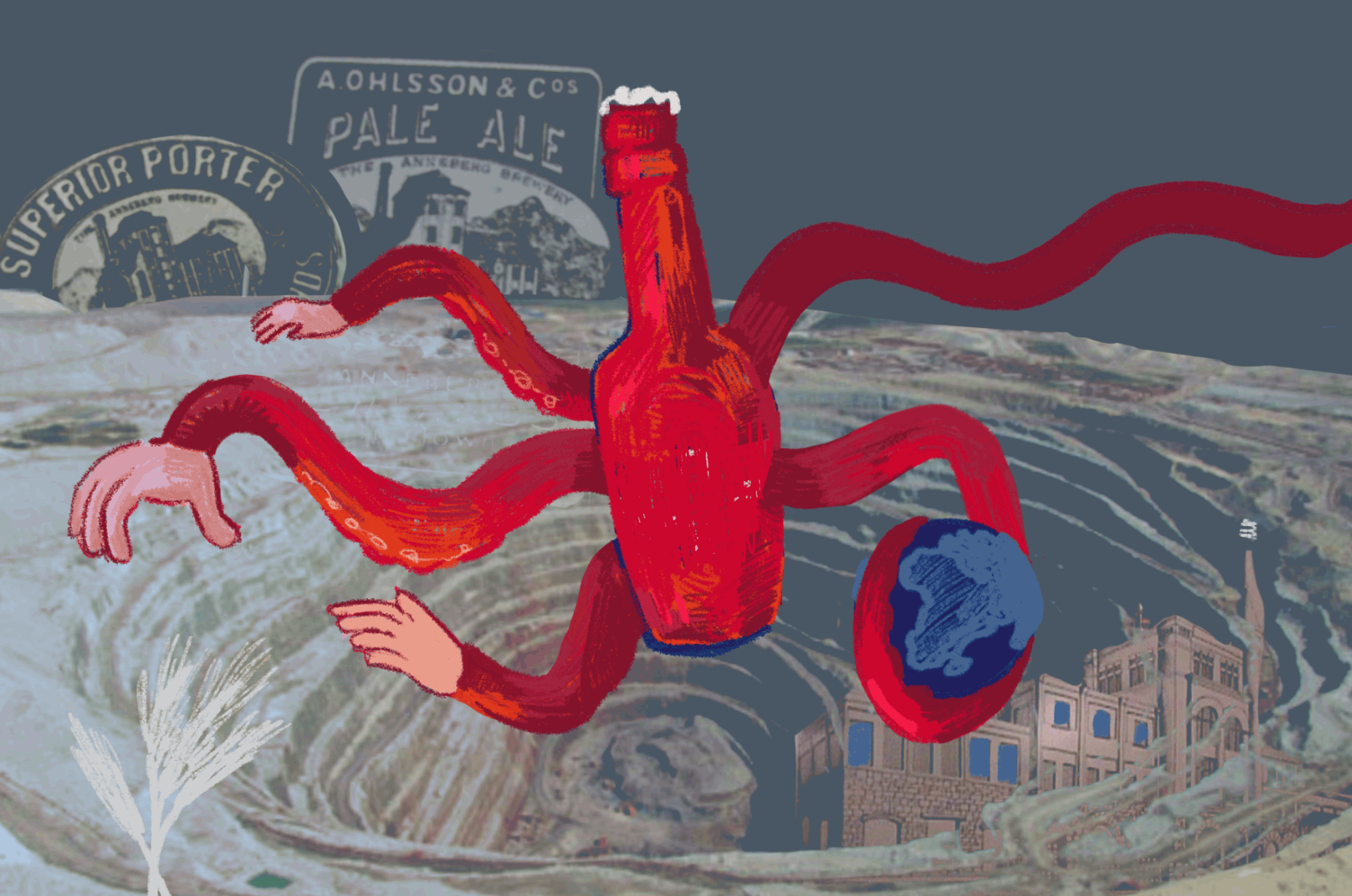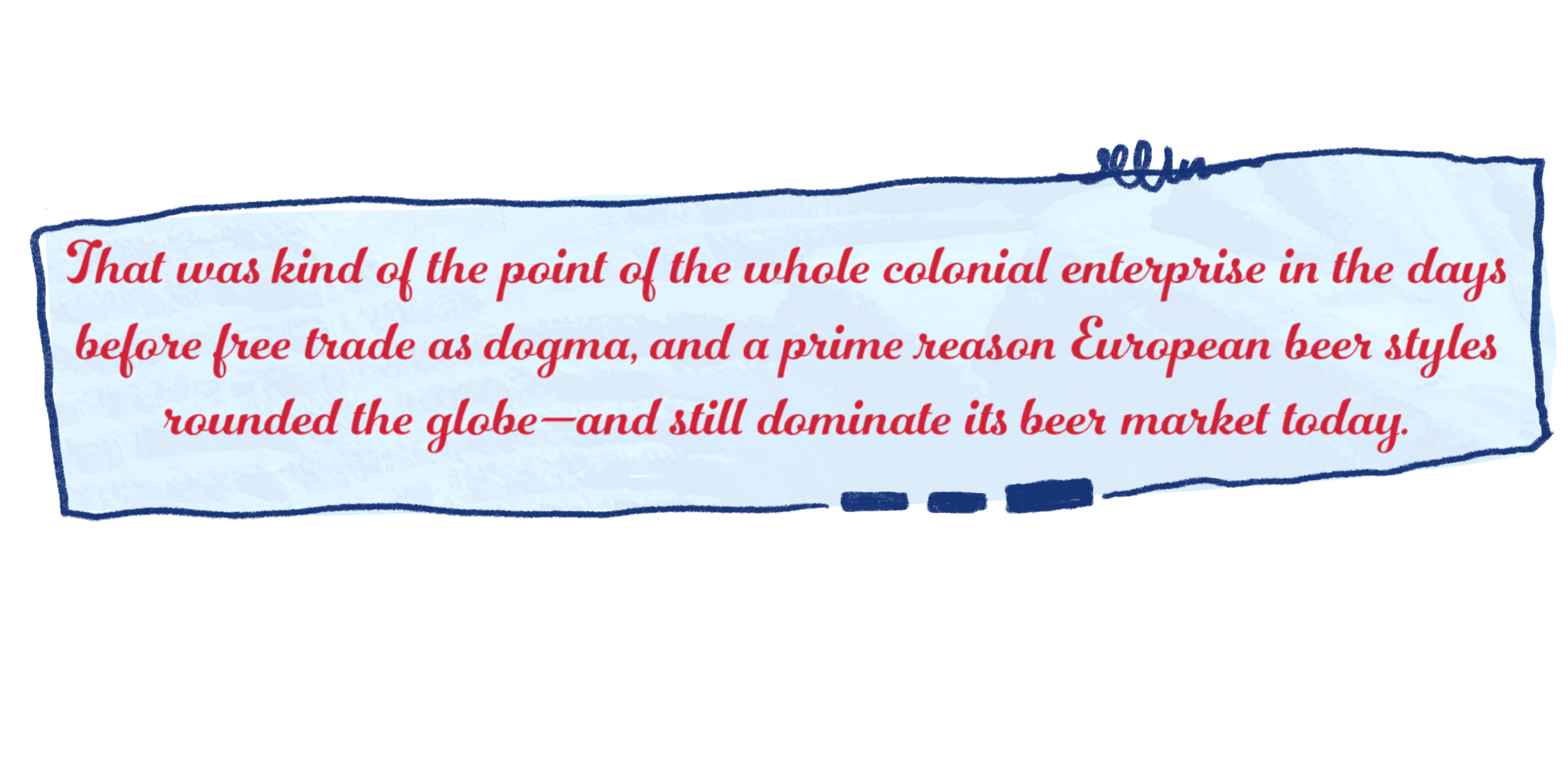Among the surest signs of the German colonizers’ presence in southwestern Africa were the large piles of empty beer bottles outside the empty diamond mines.
The rubbish could be considered a proxy for the colonial power’s approach to the area (which became modern-day Namibia after passing into British and South African control, starting in World War I, before independence in 1990). The Germans had arrived in earnest in the early 1880s to exploit the region’s natural resources, particularly its diamonds. They didn’t seem to care what damage they inflicted, be it mounds of beer bottles or genocide against the Herero, which resulted in the deaths of tens of thousands and the confinement of thousands more in concentration camps.
Mercantilism, the idea that animated European colonialism in the Age of Empire, meant taking as much territory—and the resources within it—as quickly as possible, so the other guy couldn’t have it and exploit it just the same. “It’s direct competition, and there’s only so much wealth in the world, and the more we get is less for our enemies and competitors,” says Troy Bickham, a history professor at Texas A&M University whose specialties include the British Empire. “And that drives the train.”
This centuries-long scramble would profoundly affect both the colonized and the colonizers in myriad ways, including how foodstuffs moved around the globe. Though often overlooked amidst the sheer scope of the brutality involved in colonization, Europe’s mercantilist-inspired imperialism had the side effect of spreading the continent’s beer further and farther than it had ever traveled before.
The result is that lighter-tasting and -colored Lagers—Pilsner in particular—would enjoy a global reach that has never really retracted since. But darker, stronger styles such as Porter and India Pale Ale would also ride the train.
The first professional European brewer arrived in what’s now Namibia and South Africa in 1694, when Rutgert Mensing schoonered in from Amsterdam. He brought with him a lot of technical knowledge, as well as the support of the Dutch authorities who had begun colonizing the area 40 years before. Mensing quickly set about building a brewery in a part of present-day Cape Town.
He found an already-growing market. In the decades ahead of Mensing’s arrival, the Dutch and other European colonizers had begun to recreate the Ales that were popular back home, so much so that that same area of Cape Town became known as the “Tavern of the Sea.” It served as a kind of bibulous way station for ships rounding the Horn of Africa on their way to southern Asia, according to Malcolm Purinton, who has extensively researched the region’s beer history (including for a 2016 PhD thesis for Northeastern University on the rise of Pilsner in particular).
Meanwhile, there is little evidence that indigenous fermented drinks were enjoyed or consumed in any meaningful way by the colonialists. The relatively quick rise of European ale in southern Africa pushed local alcohol, including Umqombothi, which had been made for centuries from maize and sorghum, to the commercial and cultural margins. “[T]heir beer production and consumptions did not affect the welfare of white South African brewers or beer importers who had European connections,” Purinton wrote of African alcohol producers and consumers.
But it wasn’t just that European interlopers paid hardly any mind to indigenous drinking traditions—mostly, they thought of what they brought to South Africa and elsewhere across the continent as better than what they found there.
“There’s no question that Europeans felt their culture was superior to that of the people they were conquering; that racism was a big part of the justification for imperialism; and that beer was one of the elements that distinguished Europeans,” says Jeffrey Pilcher, a professor of food history at the University of Toronto.
Combine this chauvinistic racism with that mercantilist lust, and the spread of European beer quickly became a race among various colonizers. In southern Africa, that meant British and Dutch brewers, importers, and styles competed with German ones. (The British would gradually supplant the Dutch and their descendants as the colonial power in present-day South Africa.)
A stout, mustachioed Swede named Anders Ohlsson embodied that tension. In the early 1860s, the 23-year-old Ohlsson partnered with another Scandinavian on a business that imported steel and timber from southern Africa to northern Europe. A tribal war in 1880 interrupted this trade, however, and Ohlsson turned to brewing to make his mint despite having basically no experience in the field.
He settled on land in early 1881 in the British redoubt at Cape Town, and hired a London firm well-known for designing and rigging English brewing. “They used an English brewery design, built with English oak, and installed English brewing equipment,” Purinton wrote. Ohlsson even sent one of his brewers back to England to study the latest techniques, including ways to prevent mashes from clumping and how to better measure the concentration of sugar in wort.
Throughout the 1880s, the Porters, Stouts and Pale Ales from the Swede’s Cape Town brewery would make him the most prominent, and probably the wealthiest, brewer in southern Africa, as well as a major player in colonial politics.
And he had reached that level relatively quickly using European—mainly British—brewing techniques, engineering, and recipes (and via acquiring other breweries that made similar styles). The only thing he drew from the land where he lived and worked—and would die—were the raw ingredients. Africans might have entered into the equation as laborers, but in Ohlsson’s mind, any skilled work simply had to come from Europe.
It’s no surprise, then, that Ohlsson saw his greatest competition as coming from thousands of miles north rather than his own backyard. During the period when Ohlsson built his brewing empire, the German Empire began colonizing what would become present-day Namibia just to Cape Town’s northwest. These Germans brought with them a ferocious thirst for lighter Lagers, rather than heavier Ales.
In 1884, the first year that imperial Germany really began to assert its control over Namibia—the same year German Chancellor Otto von Bismarck opened a multi-session summit of European powers to divvy up Africa without a single African present—a remarkable 64% of the total weight of exports from the major port of Hamburg to Africa was alcohol, most of it beer, Purinton wrote.
All of this was fine for Ohlsson, so long as the Germans stayed away from his business. Gold rushes starting in the late 1880s, however, brought the colonizing Germans farther south. The beer trade in colonial South Africa changed dramatically, and Ohlsson with it. Under the reigning worldview of mercantilism, Ohlsson had to not just compete alongside these Lager producers, he had to overtake them—dominate them—lest they permanently subsume his share of the market.
Out went Ales at his operation, and in came Lagers—the lighter ones in those bottles that would pile up outside of the diamond mines. By the close of the 19th century, one set of European brewing styles and techniques had supplanted another in the region.
Ohlsson acknowledged as much at the turn of the 20th century. Then around 60, and with his busiest days behind him, he told a reporter that there “was no comparison” between the beer of South Africa in 1900 and the beer he’d found when he arrived in the 1860s. More than a generation had passed, and continental Lager had planted itself even more firmly than British Ale had.
There was one curious exception, but the certainty of its exceptionality is lost to history. “Tickey Beer” pops up in the history of South African food and drink as slang for what was likely very cheap, and very cheaply made, ale. The accounts that mention it describe Tickey as light-colored and light-tasting, similar perhaps to a particularly watery Pale Ale. Mostly, though, it’s remembered for its low cost and the corners that brewers apparently cut to make it. “Tickey” itself was the nickname for a threepence coin in the colony. It’s unclear, though, if Europeans—the Dutch perhaps—created Tickey Beer, or if it evolved from an indigenous drink.
Whatever the origins, Tickey was a big seller for Ohlsson and other European brewers. Purinton estimated that in 1883, Ohlsson’s Cape Town operation produced five hogsheads of Tickey to one of Pale Ale, “and the prosperity of the brewery was dependent upon this style of beer.” If Tickey did come from the colonized peoples of southern Africa, the contribution went unrecognized.
In September 1759, a country squire in one of the British Empire’s many North American fiefdoms requested in scratchy yet precise handwriting that a London merchant send him “1 Hogshead best Porter.” No domestic producers brewed the famed English ale style in George Washington’s Virginia. It simply had to come from the metropole.
The future revolutionary’s request was part of a larger order for London goods and a small missive amid the galaxy of correspondence from Washington that the University of Virginia Press and the National Archives have preserved and collated. Yet it profoundly underscores how European beer styles and brewing techniques expanded behind colonialism—and beyond mercantilism. It wasn’t just about naked land grabs. Sometimes colonizers’ methods were more subtle.
For one thing, many members of the colonial gentry were obsessed with their standing in the empire. They would never be earls or dukes—and famously would never have direct representation in Parliament in London—but they could still mimic their overlords. That included their culinary habits.
This desire extended from the top of colonial society on downward. Washington, who inherited a vast estate with several farms worked by hundreds of slaves, could afford the latest London fashions. Others further down the chain might hope for less—but still less of the same.
“The foreign goods became a source of status for the natives,” Pilcher says. “The adoption of those goods, like beer, was a way that they could kind of be on the level with the foreigners.”
Sometimes this jones was just that: an addiction to alcohol. Many of the Native Americans whom Washington and others of European descent displaced became dependent on the rum and the whiskey proffered as bribes or weapons by the colonizers.
For most, though, the adoption of foreign norms when it came to beer and other types of alcohol had little to do with addiction and more with habit—especially, and probably because, it often ran crosscurrent with indigenous culture. Pilcher notes that the Young Bengal Movement of the 1840s in British-dominated India adopted drinking alcohol not necessarily because its followers liked it, but because it was a way to show they were more pro-Western than earlier generations of Indians.
In parts of colonized Africa, older Indigenous men often controlled the alcohol supply. Younger men could bypass that, though, by working for Europeans, Pilcher says. They then embraced the foreigners’ alcohol, beer included, and perhaps most prominently so in Africa and East Asia, over local beverages.
What’s more, this gravitation toward the beer and booze of the colonizers aided colonization itself. In South Africa, in probably the starkest example, the British authorities eventually required that African laborers drink in government-controlled (and -surveilled) establishments in the city of Durban. The revenue from these sales in turn helped finance the apartheid state, Pilcher notes.
On a less repressive scale, mundane fees for licenses and concessions for selling or making alcohol—or the ingredients for alcohol, such as grain and grapes—in numerous European empires went into the pockets of imperialists. Even well-connected brewers from Europe, such as Anders Ohlsson, had to secure the right papers to produce and sell their beer.
Then there were the wider imperial systems of trade. Having scrambled to grab more land and resources than the next power, European colonizers set about forcing their various possessions to trade with one another in specific goods, and only through the metropoles.
In the British Empire, for example, that meant that a planter growing tobacco in North Carolina couldn’t sell to a trader in Bombay—it had to instead go through London, Texas A&M’s Bickham says. The same went for someone producing Porter in northern England and selling it in Virginia. Or, more relevant for today’s beer world, a brewery in late-18th-century London could produce and expect to export a particularly bitter Pale Ale to an India increasingly dominated by British business agents and their mercenaries. The first modern breweries in India wouldn’t arrive for decades yet, which meant the only source of commercial beer came from and via the metropole.
Such imperial capitals—including Paris, Madrid, and Amsterdam—became the central hubs of global trading wheels.
The empires they helmed also divided their overseas domains into zones. Certain areas of the Spanish and British empires in particular were only allowed to commercially produce particular goods. Pre-Revolution America remained primarily agrarian, for one, and the British Isles themselves—including colonized Ireland—remained the origin of much of the empire’s beer. This zoning and trade not only swelled the bottom line of the imperialists but also fostered a dependency among the colonized—with a side of overt increased exploitation.
That was kind of the point of the whole colonial enterprise in the days before free trade as dogma, and a prime reason European beer styles rounded the globe—and still dominate its beer market today. Divvied-up lands full of people looking for status—or simply access to a product that required the colonizers’ approval, and often capital—ensured a closed playing field. The colonizers made money off the situation, and hardened their grip that much more.
“Some of it’s about revenue for the government,” Bickham says, “and a lot of it is about control.”















